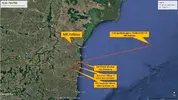The National Intelligence Service announced on the 18th that North Korea began moving special forces for dispatch to Russia on the 8th.
In early August, the National Intelligence Service captured Kim Jong-sik, first vice director of the Munitions Industry Department, a key figure in North Korea's missile development, visiting a North Korean KN-23 missile launch site near the Russian-Ukrainian front several times with dozens of North Korean military officers and providing on-site guidance.
Afterwards, the National Intelligence Service closely monitored the movements of the North Korean military, and from the 8th to the 13th, it captured North Korea transporting special forces to Russian territory via a Russian naval transport ship, confirming the start of the North Korean military's participation in the war.
According to the National Intelligence Service, four landing ships and three escort ships belonging to the Russian Pacific Fleet completed the first transport of approximately 1,500 North Korean special forces from the areas near Chongjin, Hamhung, and Musudan (Attachment 1) to Vladivostok, Russia during the same period, and a second transport operation is scheduled to take place soon.
This is the first time that the Russian Navy has entered North Korean waters since 1990. In addition, large transport aircraft such as the AN-124 of the Russian Air Force are frequently flying between Vladivostok and Pyongyang.
The North Korean soldiers dispatched to Russia are currently stationed at Russian military bases in the Far East, including Vladivostok, Ussuriysk (Appendix 2), Khabarovsk (Appendix 3), and Blagoveshchensk, and are expected to be deployed to the front lines as soon as they complete their adaptation training.
Kim Jong-un inspected the special forces twice prior to the deployment, on the 11th of last month and the 2nd of this month (Attachment 4).
The North Korean soldiers were issued Russian military uniforms and Russian-made weapons, and were also issued fake ID cards of residents of the Yakutia and Buryatia regions of Siberia (Appendix 5) who looked similar to North Koreans. It appears that they disguised themselves as Russian soldiers to hide the fact that they were deployed to the battlefield.
On this day, the National Intelligence Service assessed that North Korea had provided Russia with weapons capable of killing people, including shells, missiles, and anti-tank rockets, amounting to over 13,000 containers (Attached Files 6 and 7) on approximately 70 occasions since August of last year.
According to the verification of North Korean weapons collected from the battlefield by the Ukrainian Defense Intelligence Agency, the weapons that North Korea provided to Russia included 122mm and 152mm shells, Bulsae-4 anti-tank missiles (Appendix 8), short-range ballistic missiles such as the KN-23 (Appendix 9), and RPG anti-tank rockets (Appendix 10).
Considering the size of containers loaded on cargo ships traveling between North Korea and Russia, it appears that more than 8 million rounds of 122mm and 152mm shells have been provided to Russia so far.
The Ukrainian government announced that the KN-23 short-range ballistic missiles that North Korea provided to Russia were used in attacks on major cities, including the Ukrainian capital Kiev, resulting in a significant number of civilian casualties.
However, Ukrainian intelligence authorities analyzed that many North Korean weapons have a high defect rate and low accuracy, so they are being used for mass offensives to maintain the front line rather than for precision strikes.
A National Intelligence Service official said, “The suspicions raised by foreign media outlets regarding ‘direct military cooperation between Russia and North Korea’ have been officially confirmed,” and “We will continue to track and confirm movements in military cooperation between Russia and North Korea through close intelligence cooperation with allied countries.”
-
(Attachment 1) Activities of Russian ships for the purpose of transporting North Korean troops (10.12)ㆍSynopsis of Russian landing ships transporting North Korean troops in the East Sea
-
(Attachment 2) Military facility in Ussuriisk, Primorsky Krai (estimated 400 North Korean personnel gathered in parade ground, 10.16)
-
(Attachment 3) Military facility in Khabarovsk (estimated number of North Korean personnel: 240 people gathered, 10.16)
-
(Attachment 4) Photo of Kim Jong-un observing special warfare training (9.11)
(jätin tästä kaksi kuvaa pois, katso ne linkin takaa jos kiinnostaa)
-
(Attachment 5) Appearance of a resident of the Republic of Yakutia and Buryatia disguised as a North Korean soldier
< Residents of the Republic of Yakutia > < Residents of the Republic of Buryatia >
* Turkic, living in Northern Siberia * Mongolian, living in Eastern Siberia
-
(Attachment 6) Russian ship (Angara) carrying North Korean weapons departing from Najin Port
-
(Attachment 7) Russian ship (Lady R) carrying North Korean weapons departing from Najin Port
-
(Attachment 8) Phoenix-4
-
(Attachment 9) Remnants of North Korean KN-23 captured by Ukrainian forces
-
(Attachment 10) North Korean multiple rocket launcher (left) and North Korean 9M113 anti-tank missile (right) acquired by the Ukrainian military

 www.youtube.com
www.youtube.com






